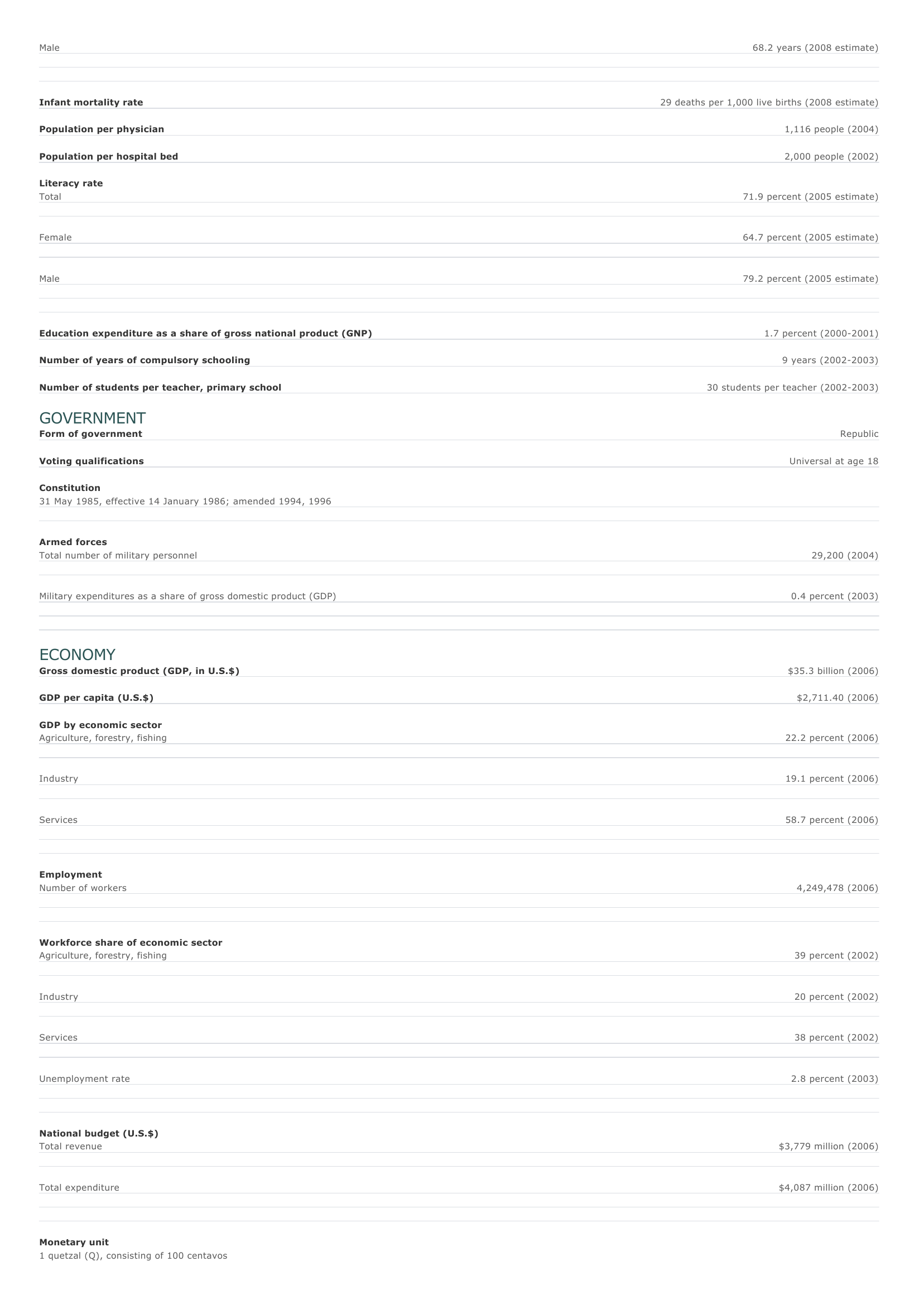
Guatemala Facts and Figures. BASIC FACTS Official name Republic of Guatemala Capital Guatemala City Area 108,889 sq km 42,042 sq mi PEOPLE Population 13,002,206 (2008 estimate) Population growth Population growth rate 2.11 percent (2008 estimate) Projected population in 2025 17,564,073 (2025 estimate) Projected population in 2050 22,995,434 (2050 estimate) Population density 120 persons per sq km (2008 estimate) 311 persons per sq mi (2008 estimate) Urban/rural distribution Share urban 47 percent (2005 estimate) Share rural 53 percent (2005 estimate) Largest cities, with population Guatemala City 942,348 (2002) Mixco 403,689 (2002) Villa Nueva 355,901 (2002) San Pedro Carchá 148,344 (2002) Cobán 144,461 (2002) Ethnic groups Ladino (mestizo) 56 percent Native American 44 percent Languages Spanish (official); more than 20 Native American languages, including Quich*, Cakchiquel, and Kekch* Religious affiliations Roman Catholic 84 percent Protestant 13 percent O ther 3 percent HEALTH AND EDUCATION Life expectancy Total Female 70 years (2008 estimate) 71.9 years (2008 estimate) Male Infant mortality rate 68.2 years (2008 estimate) 29 deaths per 1,000 live births (2008 estimate) Population per physician 1,116 people (2004) Population per hospital bed 2,000 people (2002) Literacy rate Total 71.9 percent (2005 estimate) Female 64.7 percent (2005 estimate) Male 79.2 percent (2005 estimate) Education expenditure as a share of gross national product (GNP) Number of years of compulsory schooling Number of students per teacher, primary school 1.7 percent (2000-2001) 9 years (2002-2003) 30 students per teacher (2002-2003) GOVERNMENT Form of government Republic Voting qualifications Universal at age 18 Constitution 31 May 1985, effective 14 January 1986; amended 1994, 1996 Armed forces Total number of military personnel Military expenditures as a share of gross domestic product (GDP) 29,200 (2004) 0.4 percent (2003) ECONOMY Gross domestic product (GDP, in U.S.$) GDP per capita (U.S.$) $35.3 billion (2006) $2,711.40 (2006) GDP by economic sector Agriculture, forestry, fishing 22.2 percent (2006) I ndustry 19.1 percent (2006) Services 58.7 percent (2006) Employment Number of workers 4,249,478 (2006) Workforce share of economic sector Agriculture, forestry, fishing 39 percent (2002) I ndustry 20 percent (2002) Services 38 percent (2002) Unemployment rate 2.8 percent (2003) National budget (U.S.$) Total revenue $3,779 million (2006) Total expenditure $4,087 million (2006) Monetary unit 1 quetzal (Q), consisting of 100 centavos Major trade partners for exports United States, El Salvador, South Korea, Nicaragua, and Costa Rica Major trade partners for imports United States, Mexico, South Korea, El Salvador, and Venezuela ENERGY, COMMUNICATIONS, AND TRANSPORTATION Electricity production Electricity from thermal sources 57.09 percent (2003 estimate) Electricity from hydroelectric sources 31.24 percent (2003 estimate) Electricity from nuclear sources Electricity from geothermal, solar, and wind sources 0 percent (2003 estimate) 11.67 percent (2003 estimate) Number of radios per 1,000 people 79 (1997) Number of telephones per 1,000 people 99 (2005) Number of televisions per 1,000 people 55 (2000 estimate) Number of Internet hosts per 10,000 people 17 (2003) Daily newspaper circulation per 1,000 people 31 (1996) Number of motor vehicles per 1,000 people 57 (1999) Paved road as a share of total roads 35 percent (1999) SOURCES Basic Facts and People sections Area data are from the statistical bureaus of individual countries. Population, population growth rate, and population projections are from the United States Census Bureau, International Programs Center, International Data Base (IDB) (www.census.gov). Urban and rural population data are from the Food and Agriculture Organization (FAO) of the United Nations (UN), FAOSTAT database (www.fao.org). Largest cities population data and political divisions data are from the statistical bureaus of individual countries. Ethnic divisions and religion data are largely from the latest Central Intelligence Agency (CIA) World Factbook and from various country censuses and reports. Language data are largely from the Ethnologue, Languages of the World, Summer Institute of Linguistics International (www.sil.org). Health and Education section Life expectancy and infant mortality data are from the United States Census Bureau, International Programs Center, International database (IDB) (www.census.gov). Population per physician and population per hospital bed data are from the World Health Organization (WHO) (www.who.int). Education data are from the United Nations Educational, Scientific and Cultural Organization (UNESCO) database (www.unesco.org). Government section Government, independence, legislature, constitution, highest court, and voting qualifications data are largely from various government Web sites, the latest Europa World Yearbook, and the latest Central Intelligence Agency (CIA) World Factbook. The armed forces data is from Military Balance. Economy section Gross domestic product (GDP), GDP per capita, GDP by economic sectors, employment, and national budget data are from the World Bank database (www.worldbank.org). Monetary unit, agriculture, mining, manufacturing, exports, imports, and major trade partner information is from the statistical bureaus of individual countries, latest Europa World Yearbook, and various United Nations and International Monetary Fund (IMF) publications. Energy, Communication, and Transportation section Electricity information is from the Energy Information Administration (EIA) database (www.eia.doe.gov). Radio, telephone, television, and newspaper information is from the United Nations Educational, Scientific and Cultural Organization (UNESCO) database (www.unesco.org). Internet hosts, motor vehicles, and road data are from the World Bank database (www.worldbank.org). Note Figures may not total 100 percent due to rounding. Microsoft ® Encarta ® 2009. © 1993-2008 Microsoft Corporation. All rights reserved.





